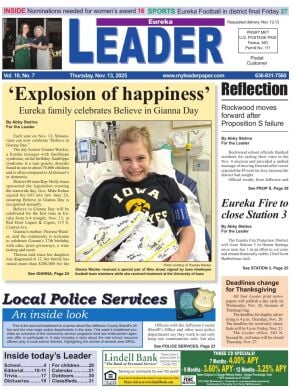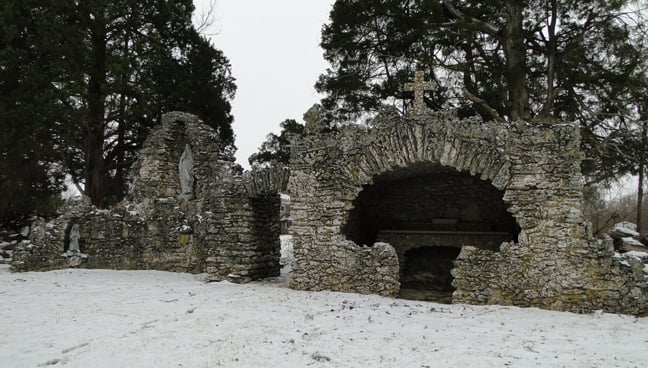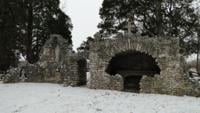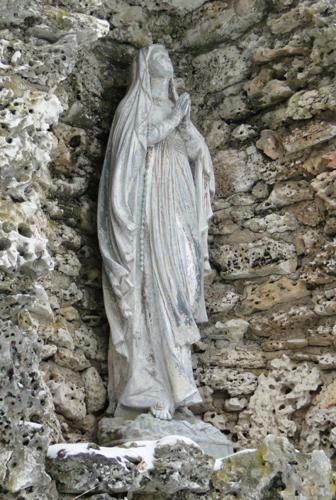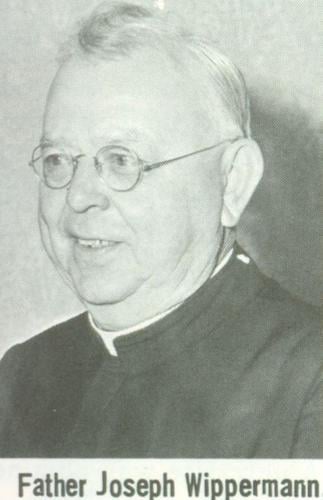On Rock Creek Road, about three miles from Hwy. 30, is a monument made of rocks known as the Shrine to Our Lady of Perpetual Help. The grotto, built in the 1930s on property near the first St. John Catholic Church, was a labor of love for one priest—Father Joseph Wipperman, who served Jefferson County Catholics for nearly 30 years.
At one time, Rock Creek was a community in northwestern Jefferson County. That place is now a part of High Ridge. A group of Bohemian immigrants (from what is now the Czech Republic) settled there in the mid-1800s. A priest by the name of Heinrich Brockhagen, who was the pastor of Immaculate Conception Catholic Church in Maxville (now Arnold), came to encourage them to build a church and they did.
St. John Catholic Church, which was completed in 1861, was one of the earliest churches in Jefferson County, according to Della Lang in her book “Along Old Gravois.”
Fast forward about 60 years and Father Joseph Wipperman began his 28-year tenure at St. John’s, from 1918 until 1946. St. John’s wasn’t the only church Wipperman served. He, like Brockhagen, was permitted to organize a mission church nearby in the High Ridge area in 1921, which one day would be St. Anthony’s Catholic Church in High Ridge, according to Lang.
He also inspired the men of the church to build the Grotto.
A grotto can be a natural cave or any structure built to look like a cave. Often the niches, the hollows in the rock structure, are filled with statuary and the rocky walls and surrounding grounds adorned with plants. Grottos are often used by the religious as places of contemplation and prayer.
According to St. John’s Centennial booklet, the grotto Wippermen built became a landmark on Rock Creek Road.
“Not only his inspiration and direction went into the building of the grotto, but many, many hours of his own labor were devoted to the gathering of the stones and the actual building of the shrine. Included in the grotto was a stone altar, and, in good weather, the Sunday Masses were offered here, outdoors, ‘in God's own church,’” the history states.
The grotto consisted of two structures, both built of Ozark honeycombed limestone. The cave-like structure was 26-feet long and 18-feet high. The shrine itself was 22-by-22 feet.
The grotto was dedicated to Our Lady of Perpetual Help in 1939, according to a newspaper article titled “Dedication of Grotto, Shrine at Rock Creek" in the Jefferson Democrat newspaper on July 20, 1939.
"St. Johns Parish at Rock Creek will dedicate its grotto and shrine to Our Lady of Perpetual Help on Sunday, Aug. 6th at three o'clock. The Redemptorist Fathers of De Soto Novitiate will officiate. The sermon will be preached by the Very Rev. Edward Rogers, also of DeSoto and dean of Jefferson County,” the announcement said.
The original picture of Our Lady of Perpetual Help is a product of Byzantine art. It is known to be at least 500 years old in its present form and is enshrined at the church of Sant’Alfonso di Liguori in Rome. The painting is said to be associated with miracles through the years. A perpetual novena to Our Lady of Perpetual Help began in St. Louis in 1927, which is possibly why Wipperman chose the dedication.
Wipperman, however, served St. John during one of the more difficult decades, during the Great Depression, and during the decade that followed church attendance began to wane. The priest retired in 1946 due to poor health. The church began to deteriorate and was closed. In 1954, members decided to move the congregation and build a new church. In 1957, a new church was built on Hwy. 21, and in 2011, St. John’s completed its third church building just off Hwy. 21 on Blue Springs Road, near the Shady Valley exit just south of its second location.
The grotto remains near the cemetery on the grounds of St. John’s first school, which was sold and is now a private residence. The grotto still belongs to the church, although the property does not, said Retta Nahlik, a member who, coincidently or not, has the same last name as the first couple married in the church -- John and Mary Nahlik, who were wed on November 3, 1869.
“We hope to move the grotto to the new church one day,” she said.
Send submissions to LOOKING BACK to nvrweakly@aol.com or bring or mail them to the Leader office, 503 N. Second St., Festus (P.O. Box 159, 63028). Please include your name, phone number, a brief description of what’s in the photo and tell us how you came by it. Please also include when it was taken, where and by whom (if known). A new LOOKING BACK photo will be posted each week.

